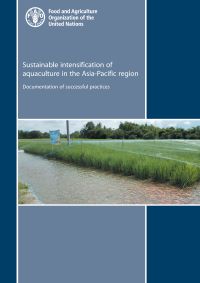Promising aquaculture practices for sustainable intensification
4 March 2013 | Peter Edwards | 5497 views | .mp4 | 68.61 MB | Echinoderms (sea cucumbers, urchins), Environment and Sustainability
The challenge of feeding nine billion people is three-fold: to meet the food demand of a fast-growing and more affluent population; to do so in environmentally and socially sustainable ways; and to ensure the world’s poorest people do not go hungry. Given natural resource limits, technological change and intensification will be required to maximize productivity and optimize across a complex land (water) scape of production, rural development, environment, social justice, and food consumption outcomes. The concept of sustainable intensification emerged in agriculture, faced with limited potential for increase in area of terrestrial crops and livestock. Aquaculture, the third and relatively underdeveloped food producing sector, has already seen exponential growth over the past 15 years, especially in Asia, and has a great potential to expand on both land and water in most Asian countries contributing significantly to food and nutritional security, livelihoods and poverty alleviation, and economic growth. Lessons have been learned from disastrous losses e.g. through disease epidemics, caused by unfettered and unsustainable over-exploitation of aquatic resources. The challenge for sustainable intensification of aquaculture will therefore be to develop resilient systems to accomplish these outcomes whilst minimizing adverse environmental, food safety and social impacts.
A range of technologies shows promise for increasing productivity in key systems in inland and coastal systems. Many of them link traditional and modern practice to reduce cost of production and adverse environmental impact of modern pellet-fed aquaculture and the integrate systems to treat effluents.
The continuing poverty faced by vast numbers of traditional small-scale aquaculturists attests to its inadequacy as a major livelihood. Farmers need to intensify to secure their livelihoods. Many such traditional systems are suited to low-cost diversification, using improved seed and direct/indirect indole-3-acetic acid (IAA) feed as a first step on the ladder of intensification. Indirect agriculture-aquaculture integration and/or use pelleted feed offers a second route with huge potential, especially in fewer developed Asian countries.
Whilst the importance and potential of rice/fish culture is grossly overestimated, conversion of rice paddies to fish ponds can yield much higher returns (e.g. in the Red River Delta, Viet Nam) especially when stocked with high quality juveniles. Moreover, Asia has an estimated 67 million ha of small community-owned water bodies constructed mainly for irrigation, creating a huge potential for culture- based fisheries. The feed value of aquatic macrophytes such as water spinach is under-appreciated but has finally been recognized by FAO.
Other promising technologies for pond intensification include modern polyculture, biofloc and diffuse aeration. With the highest recorded agricultural commodity production in the world (400–600 tonnes/ ha/8 month crop in Viet Nam), sustainable intensification of Pangasiid catfish aquaculture offers a glimpse of the potential productivity improvement. In these operations are environmentally sustainable as ponds are flushed by the Mekong River, and nutrient loading from catfish ponds is minor compared to that from agriculture, industry and human settlements, and within the carrying capacity of the Mekong River and the South China Sea. There is a huge potential for adoption in Myanmar as Ayeyarwaddy Delta has abundant water and soybean could be grown in-country as feed.
Use of inorganic fertilizers to ‘green’ ponds or reservoirs can reduce feed costs in tilapia and pearl production, supplemented later with pelleted feed, whilst in aquaponics systems, effluents from intensive tank culture of tilapia fertilize terrestrial vegetables on floats. Biofloc systems are suited to intensive culture of fish and shrimps. Addition of low-value carbohydrate-rich supplementary feed, combined with aeration produces protein-rich bioflocs can reduce feed requirement by 30 percent.
Recirculation aquaculture systems (RAS) are useful for producing high-value species in which good environmental control or high biosecurity is required (e.g. specific pathogen free (SPF) shrimp, barramundi nursing) or where land or water are scarce or expensive, and for public aquaria. Where water is scarce, partitioned aquaculture systems can potentially reduce water usage per unit of fish by 90 percent, as well as facilitating management and harvest. Promising technologies for cages include low-volume high-density (LVHD) cage culture, cage-in-pond culture systems and integrated freshwater cage aquaculture.
Examples of promising technologies for sustainable intensification include the ‘landscape approach’ for small-scale farmers with shrimp ponds integrated into intertidal zone to maintain ecological functions of mangroves, and closed re-circulation ponds constructed on an industrial scale, located above the inter-tidal zone to help eliminate problems of disease and effluent.
Integrated multi-trophic aquaculture (IMTA) offers a new approach that integrates pellet-fed finfish with inorganic extractive seaweeds, organic extractive mollusks and benthic detritivores, e.g. sea cucumber, either in open water or as land-based systems. Such systems were first developed in China as first seaweeds, then scallops and later finfish cage culture were sequentially developed on commercial scale in coastal bays. IMTA is still at the experimental stage and more research is needed on carrying capacity. Closed marine systems and land-based IMTA is also mainly experimental, but has been commercialized in Israel.
In conclusion, although there is no panacea on the horizon, there is a huge potential to increase Asian aquaculture productivity through wider dissemination of existing technologies, especially in less developed countries. It seems unlikely that RAS and offshore cages will be adopted in Asia in the near future due to their high cost and complexity. Also, significant reduction of nutrients in intensive pond and cage aquaculture effluents remains an elusive goal. Greater implementation of BMPs will improve efficiency of existing systems, and EAA will contribute to more appropriate integration of aquaculture with other land uses, and to preserving environmental integrity.
Creative Commons Attribution.
